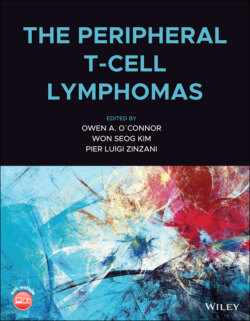Читать книгу The Peripheral T-Cell Lymphomas - Группа авторов - Страница 72
Angioimmunoblastic T‐cell Lymphoma
ОглавлениеGene expression profiling and immunohistochemical staining indicate that AITL tumor cells exhibit a T follicular helper (Tfh) phenotype [1]. Tfh cells exist in follicles of lymph nodes and spleen, and support B‐cell survival, proliferation, migration, and differentiation [2]. Tfh phenotypes, both in the context of normal helper T cells and in AITL cells, are determined by expression of co‐stimulatory molecules such as inducible T‐cell co‐stimulator (ICOS) and programmed cell death 1, as well as by chemokine receptors, such as C‐X‐C motif chemokine receptor 5 and C‐X‐C motif chemokine ligand 13, and membrane metalloendopeptidase, such as CD4 and CD10, and a key transcription factor governing Tfh development, namely, B‐cell lymphoma 6 protein (BCL6, [1]). Several animal models have been established to assess AITL pathogenesis.
